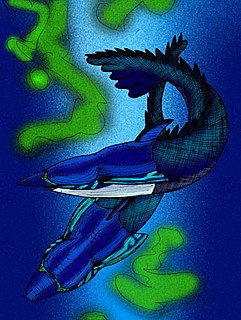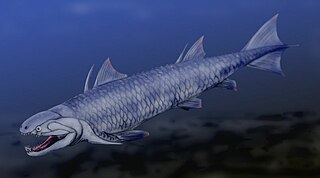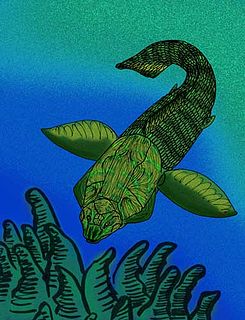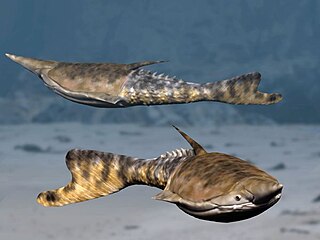
Placodermi is a class of armoured prehistoric fish, known from fossils, which lived from the Silurian to the end of the Devonian period. Their head and thorax were covered by articulated armoured plates and the rest of the body was scaled or naked, depending on the species. Placoderms were among the first jawed fish; their jaws likely evolved from the first of their gill arches. Placoderms are thought to be paraphyletic, consisting of several distinct outgroups or sister taxa to all living jawed vertebrates, which originated among their ranks. This is illustrated by a 419-million-year-old fossil, Entelognathus, from China, which is the only known placoderm with a type of bony jaw like that found in modern bony fishes. This includes a dentary bone, which is found in humans and other tetrapods. The jaws in other placoderms were simplified and consisted of a single bone. Placoderms were also the first fish to develop pelvic fins, the precursor to hindlimbs in tetrapods, as well as true teeth. Paraphyletic groupings are problematic, as one can not talk precisely about their phylogenic relationships, characteristic traits, and complete extinction. 380-million-year-old fossils of three other genera, Incisoscutum, Materpiscis and Austroptyctodus, represent the oldest known examples of live birth. In contrast, one 2016 analysis concluded that placodermi are likely monophyletic, though these analyses have been further dismissed with more transitional taxa between placoderms and modern gnathosthomes solidying their paraphyletic status.

Heterostraci is an extinct subclass of pteraspidomorph jawless vertebrate that lived primarily in marine and estuary environments. The first identifiable heterostracans appear in the fossil record during the Early Silurian, and all, save for the Psammosteids, became extinct by the start of the late Devonian. This last group of heterostracans died out in the extinction event at the end of the Devonian.

Protaspididae is an extinct family of pteraspidid heterostracan agnathans. Fossils of the various genera are found in early Devonian-aged marine strata. Protaspidids were once thought to represent a transitional form between the Pteraspididae and the Psammosteida, bearing the broad head shield shape of the latter, due to a more benthic (bottom-dwelling) existence, but recent phylogenical comparisons demonstrate that the protaspidids are actually highly derived pteraspidids, and that the anchipteraspidids, the most primitive of pteraspidids, are the sister-group of the Psammosteids.

Dunkleosteus is an extinct genus of large armored, jawed fishes that existed during the Late Devonian period, about 382–358 million years ago. It consists of ten species, some of which are among the largest placoderms to have ever lived: D. terrelli, D. belgicus, D. denisoni, D. marsaisi, D. magnificus, D. missouriensis, D. newberryi, D. amblyodoratus, and D. raveri. The largest and most well known species is D. terrelli, which grew up to 8.79 m (28.8 ft) long and 4 t in weight. Dunkleosteus could quickly open and close its jaw, like modern-day suction feeders, and had a bite force of 6,000 N at the tip and 7,400 N at the blade edge. Numerous fossils of the various species have been found in North America, Poland, Belgium, and Morocco.

Bothriolepis was a widespread, abundant and diverse genus of antiarch placoderms that lived during the Middle to Late Devonian period of the Paleozoic Era. Historically, Bothriolepis resided in an array of paleo-environments spread across every paleocontinent, including near shore marine and freshwater settings. Most species of Bothriolepis were characterized as relatively small, benthic, freshwater detritivores, averaging around 30 centimetres (12 in) in length. However, the largest species, B. rex, had an estimated bodylength of 170 centimetres (67 in). Although expansive with over 60 species found worldwide, comparatively Bothriolepis is not unusually more diverse than most modern bottom dwelling species around today.

Cephalaspis is a possibly monotypic genus of extinct osteostracan agnathan vertebrate. It was a trout-sized detritivorous fish that lived in the early Devonian.

Pteraspis is an extinct genus of pteraspidid heterostracan agnathan vertebrate that lived from the Lochkovian to Eifelian epochs of the Devonian period in what is now Brazil, Britain, Ukraine and Belgium.

Groenlandaspis is an extinct genus of arthrodire from the Late Devonian. Fossils of the different species are found in late Devonian strata in all continents except eastern Asia. The generic name commemorates the fact that the first specimens of the type species (G.mirabilis) were found in Greenland.

Psarolepis is a genus of extinct bony fish which lived around 397 to 418 million years ago. Fossils of Psarolepis have been found mainly in South China and described by paleontologist Xiaobo Yu in 1998. It is not known certainly in which group Psarolepis belongs, but paleontologists agree that it probably is a basal genus and seems to be close to the common ancestor of lobe-finned and ray-finned fishes. In 2001, paleontologist John A. Long compared Psarolepis with onychodontiform fishes and refer to their relationships.

Lunaspis is an extinct genus of armor-plated petalichthyid placoderm fish that lived in shallow marine environments of the Early Devonian period, from approximately 409.1 to 402.5 million year ago. Fossils have been found in Germany, China and Australia. There are three different identified species of within the genus Lunaspis: L. broilii, L. heroldi, and L. prumiensis.

Incisoscutum is a genus of arthrodire placoderm from the Late Frasnian Gogo Reef, from Late Devonian Australia. The genus contains two species I. ritchiei, named after Dr. Alex Ritchie, a palaeoichthyologist and senior fellow of the Australian Museum, and I. sarahae, named after Sarah Long, daughter of its discoverer and describer, Dr. John A. Long.

Holonematidae is an extinct family of relatively large arthrodire placoderms from the Early to Late Devonian. Almost all fossil specimens are of armor fragments, though, all have distinctive ornamentation, often of unique arrangements and patterns of tubercles, that are diagnostic of the family. The trunkshield is very elongated, giving the armor an overall "barrel" like appearance.
Homostiidae is a family of flattened arthrodire placoderms from the Early to Middle Devonian. Fossils appear in various strata in Europe, Russia, Morocco, Australia, Canada and Greenland.
Microbrachius is an extinct genus of tiny, advanced antiarch placoderms closely related to the bothriolepids. Complete articulated specimens show that the armored section of the body had an average length of 2-4 cm. Species of Microbrachius are characterized by having large heads with short thoracic armor. Specimens of Microbrachius have been found in Scotland, Belarus, Estonia, and China. Specimens range in age from the Lower Devonian Late Emsian Stage to the Middle Devonian Upper Givetian Stage.

The Frænkelryggen Formation is a geologic formation in Svalbard, Norway. The fluvial sandstones and green shales preserve flora and early fish fossils dating back to the Lochkovian stage of the Early Devonian period.

Pteraspidiformes is an extinct order of heterostracan agnathan vertebrates known from extensive fossil remains primarily from Early Devonian strata of Europe and North America, and from Upper Silurian Canada.

Blieckaspis priscillae is a pteraspidid heterostracan agnathan from the Middle Devonian of North America.

Protopteraspididae is an extinct family of pteraspidid heterostracan agnathans. Fossils of the various genera are found in early Devonian-aged marine strata. Protopteraspidids were once thought to represent a taxon of basal pteraspidids but recent evaluations demonstrate that Protopteraspididae is a paraphyletic group of various transitional forms representing a gradual transition between the more advanced Pteraspoidei, and the anchipteraspidids and the Psammosteids.

Pteraspididae is an extinct family of heterostracan vertebrates. It is an Early Devonian-aged family that contains the stereotypical, torpedo-shaped pteraspidids, such as the type genus, Pteraspis, and its close relatives Errivaspis and Rhinopteraspis, that are popularly thought to have actively swam about in the water column. The elongated rostral plate is thought to help with their hydrodynamic ability. Various genera are found in various marine and estuarine strata of Early Devonian Europe and North America.

Asterolepis is an extinct genus of antiarch placoderms from the Devonian of North and South America and Europe. They were heavily armored flat-headed benthic detritivores with distinctive jointed limb-like pectoral fins and hollow spine. The armor plate gives the Asterolepis a box-like shape. Its pectoral fins are also armored but the caudal and dorsal fin are not. The first fossils were named by M. Eichwald in 1840 after noticing star-like markings on the fossils.


















